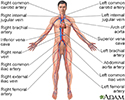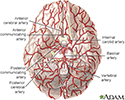Hereditary hemorrhagic telangiectasia
HHT; Osler-Weber-Rendu syndrome; Osler-Weber-Rendu disease; Rendu-Osler-Weber syndromeHereditary hemorrhagic telangiectasia (HHT) is an inherited disorder of the blood vessels that can cause excessive bleeding.
Causes
HHT is passed down through families in an autosomal dominant pattern. This means the abnormal gene is needed from only one parent in order to inherit the disease.
Autosomal dominant pattern
Autosomal dominant is one of many ways that a trait or disorder can be passed down through families. In an autosomal dominant disease, if you get the...

Scientists have identified four genes involved in this condition. All of these genes appear to be important for blood vessels to develop properly. A mutation in any one of these genes is responsible for HHT.
Symptoms
People with HHT can develop abnormal blood vessels in several areas of the body. These vessels are called arteriovenous malformations (AVMs).
If they are on the skin, they are called telangiectasias. The most common sites include the lips, tongue, ears, and fingers. The abnormal blood vessels can also develop in the brain, lungs, liver, intestines, or other areas.
Telangiectasias
Telangiectasias are small, widened blood vessels on the skin. They are usually harmless, but may be associated with several diseases.

Symptoms of this syndrome include:
- Frequent nosebleeds in children
Nosebleeds
A nosebleed is loss of blood from the tissue lining the nose. Bleeding most often occurs from one nostril only.
 ImageRead Article Now Book Mark Article
ImageRead Article Now Book Mark Article -
Bleeding in the gastrointestinal tract (GI), including loss of blood in the stool, or dark or black stools
Bleeding in the gastrointestinal tract ...
Gastrointestinal (GI) bleeding refers to any bleeding that starts in the gastrointestinal tract. Bleeding may come from any site along the GI tract, ...
 ImageRead Article Now Book Mark Article
ImageRead Article Now Book Mark Article -
Seizures or unexplained, small strokes (from bleeding into the brain)
Seizures
A seizure is the physical changes in behavior that occurs during an episode of specific types of abnormal electrical activity in the brain. The term ...
 ImageRead Article Now Book Mark Article
ImageRead Article Now Book Mark ArticleStrokes
A stroke occurs when blood flow to a part of the brain stops. A stroke is sometimes called a "brain attack. " If blood flow is cut off for longer th...
 ImageRead Article Now Book Mark Article
ImageRead Article Now Book Mark Article - Shortness of breath
-
Enlarged liver
Enlarged liver
Enlarged liver refers to swelling of the liver beyond its normal size. Hepatomegaly is another word to describe this problem. If both the liver and ...
 ImageRead Article Now Book Mark Article
ImageRead Article Now Book Mark Article -
Heart failure
Heart failure
Heart failure is a condition in which the heart is no longer able to pump oxygen-rich blood to the rest of the body efficiently. This causes symptom...
 ImageRead Article Now Book Mark Article
ImageRead Article Now Book Mark Article -
Anemia caused by low iron
Anemia
Anemia is a condition in which the body does not have enough healthy red blood cells. Red blood cells provide oxygen to body tissues. There are man...
 ImageRead Article Now Book Mark Article
ImageRead Article Now Book Mark Article
Exams and Tests
Your health care provider will perform a physical examination and ask about your symptoms. An experienced provider can detect telangiectases during a physical examination. There is often a family history of this condition.
Tests include:
-
Blood gas tests
Blood gas tests
Blood gases are a measurement of how much oxygen and carbon dioxide are in your blood. They also determine the acidity (pH) of your blood.
 ImageRead Article Now Book Mark Article
ImageRead Article Now Book Mark Article - Blood tests
- Imaging test of the heart called an echocardiogram
Echocardiogram
An echocardiogram is a test that uses sound waves to create pictures of the heart. The picture and information it produces is more detailed than a s...
 ImageRead Article Now Book Mark Article
ImageRead Article Now Book Mark Article -
Endoscopy, which uses a tiny camera attached to a thin tube to look inside your body
Endoscopy
Endoscopy is a way of looking inside the body using a flexible tube that has a small camera and light on the end of it. This instrument is called an...
 ImageRead Article Now Book Mark Article
ImageRead Article Now Book Mark Article -
MRI to detect AVMs in the brain
MRI
A head MRI (magnetic resonance imaging) is an imaging test that uses powerful magnets and radio waves to create pictures of the brain and surrounding...
 ImageRead Article Now Book Mark Article
ImageRead Article Now Book Mark Article -
CT or ultrasound scans to detect AVMs in the liver
CT
An abdominal CT scan is an imaging method. This test uses x-rays to create cross-sectional pictures of the belly area. CT stands for computed tomog...
 ImageRead Article Now Book Mark Article
ImageRead Article Now Book Mark ArticleUltrasound
Ultrasound uses high-frequency sound waves to make images of organs and structures inside the body.
 ImageRead Article Now Book Mark Article
ImageRead Article Now Book Mark Article
Genetic testing is available to look for changes in genes associated with this syndrome.
Treatment
Treatments may include:
- Surgery to treat bleeding in some areas
-
Electrocautery (heating tissue with electricity) or laser surgery to treat frequent or heavy nosebleeds
Electrocautery
Electrocauterization is the process of heating tissue with electricity.
Read Article Now Book Mark Article -
Endovascular embolization (injecting a substance through a thin tube) to treat abnormal blood vessels in the brain and other parts of the body
Endovascular embolization
Endovascular embolization is a procedure to treat abnormal blood vessels in the brain and other parts of the body. It is an alternative to open surg...
Read Article Now Book Mark Article
Some people respond to estrogen therapy, which can reduce bleeding episodes. Iron may also be given if there is a lot of blood loss, leading to anemia. Avoid taking blood-thinning medicines. Some medicines that affect blood vessel development are being studied as possible future treatments.
Some people may need to take antibiotics before having dental work or surgery. People with lung AVMs should avoid scuba diving to prevent decompression sickness (the bends). Ask your provider what other precautions you should take.
Support Groups
More information and support for people with HHT disorder and their families can be found at:
- Cure HHT -- curehht.org/
- National Organization for Rare Disorders -- rarediseases.org/rare-diseases/hereditary-hemorrhagic-telangiectasia/
Outlook (Prognosis)
People with this syndrome can live a completely normal lifespan, depending on where in the body the AVMs are located.
Possible Complications
These complications can occur:
- Heart failure
- High blood pressure in the lungs (pulmonary hypertension)
Pulmonary hypertension
Pulmonary hypertension is high blood pressure in the arteries of the lungs. It makes the right side of the heart work harder than normal.
 ImageRead Article Now Book Mark Article
ImageRead Article Now Book Mark Article - Internal bleeding
- Shortness of breath
-
Stroke
Stroke
A stroke occurs when blood flow to a part of the brain stops. A stroke is sometimes called a "brain attack. " If blood flow is cut off for longer th...
 ImageRead Article Now Book Mark Article
ImageRead Article Now Book Mark Article
When to Contact a Medical Professional
Contact your provider if you or your child has frequent nose bleeds or other signs of this disease.
Prevention
Genetic counseling is recommended for couples who want to have children and who have a family history of HHT. If you have this condition, medical treatments can prevent certain types of strokes and heart failure.
Genetic counseling
Genetics is the study of heredity, the process of a parent passing certain genes on to their children. A person's appearance, such as height, hair co...

References
Centers for Disease Control and Prevention website. Blood disorders: facts about hereditary hemorrhagic telangiectasia (HHT). www.cdc.gov/ncbddd/hht/. Updated April 28, 2023. Accessed May 1, 2023.
Cappell MS, Lebwohl O. Hereditary hemorrhagic telangiectasia. In: Lebwohl MG, Heymann WR, Coulson IH, Murrell DF, eds. Treatment of Skin Disease. 6th ed. Philadelphia, PA: Elsevier; 2022:chap 102.
Kwah J, Brandt LJ. Vascular lesions of the gastrointestinal tract. In: Feldman M, Friedman LS, Brandt LJ, eds. Sleisenger and Fordtran's Gastrointestinal and Liver Disease. 11th ed. Philadelphia, PA: Elsevier; 2021:chap 38.
McDonald J, Pyeritz RE. Hereditary hemorrhagic telangiectasia. In: Adam MP, Mirzaa GM, Pagon RA, et al, eds. GeneReviews [Internet]. Seattle, WA: University of Washington, Seattle; 1993-2023. www.ncbi.nlm.nih.gov/books/NBK1351/. Updated November 24, 2021. Accessed May 1, 2023.
-
Circulatory system - illustration
Blood used by the body is brought back to the heart and lungs by the veins of the body. Once the blood has gathered more oxygen from the lungs, it is pumped back out to the body through the arteries.
Circulatory system
illustration
-
Arteries of the brain - illustration
The internal carotid arteries and the vertebral arteries supply blood to the brain.
Arteries of the brain
illustration
-
Circulatory system - illustration
Blood used by the body is brought back to the heart and lungs by the veins of the body. Once the blood has gathered more oxygen from the lungs, it is pumped back out to the body through the arteries.
Circulatory system
illustration
-
Arteries of the brain - illustration
The internal carotid arteries and the vertebral arteries supply blood to the brain.
Arteries of the brain
illustration
Review Date: 4/24/2023
Reviewed By: Anna C. Edens Hurst, MD, MS, Associate Professor in Medical Genetics, The University of Alabama at Birmingham, Birmingham, AL. Review provided by VeriMed Healthcare Network. Also reviewed by David C. Dugdale, MD, Medical Director, Brenda Conaway, Editorial Director, and the A.D.A.M. Editorial team.




